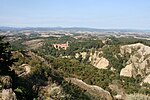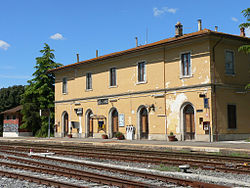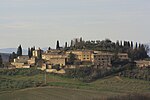Territorial Abbey of Monte Oliveto Maggiore
14th-century Roman Catholic church buildings in ItalyBenedictine monasteries in ItalyChristian monasteries established in the 14th centuryChurches in the province of SienaCrete Senesi ... and 7 more
Monasteries in TuscanyOlivetan monasteriesReligious organizations established in the 1310sRenaissance paintingsRoman Catholic dioceses in ItalyRomanesque architecture in TuscanyTerritorial abbeys

The Abbey of Monte Oliveto Maggiore is a large Benedictine monastery in the Italian region of Tuscany, 10 km south of Asciano. Its buildings, which are mostly of red brick, are conspicuous against the grey clayey and sandy soil—the Crete senesi which give this area of Tuscany its name. It is a territorial abbey whose abbot functions as the ordinary of the land within the abbey's possession, even though he is not consecrated as a bishop. It is the mother-house of the Olivetans and the monastery later took the name of Monte Oliveto Maggiore ("the greater") to distinguish it from successive foundations at Florence, San Gimignano, Naples and elsewhere.
Excerpt from the Wikipedia article Territorial Abbey of Monte Oliveto Maggiore (License: CC BY-SA 3.0, Authors, Images).Territorial Abbey of Monte Oliveto Maggiore
Strada Provinciale di Monte Oliveto,
Geographical coordinates (GPS) Address Website Nearby Places Show on map
Geographical coordinates (GPS)
| Latitude | Longitude |
|---|---|
| N 43.175277777778 ° | E 11.544166666667 ° |
Address
Abbazia di Monte Oliveto Maggiore
Strada Provinciale di Monte Oliveto
53022
Tuscany, Italy
Open on Google Maps











